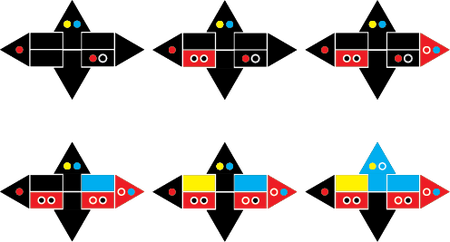Trending
Opinion: How will Project 2025 impact game developers?
The Heritage Foundation's manifesto for the possible next administration could do great harm to many, including large portions of the game development community.

Featured Blog | This community-written post highlights the best of what the game industry has to offer. Read more like it on the Game Developer Blogs or learn how to Submit Your Own Blog Post
As an expert puzzle constructor, I show in detail how I discovered a new piece of logic from a new mechanic and integrated it into an old puzzle.

Recently I've been designing new puzzles, with a new mechanic, for a third bonus world in the PC version of my game RYB. In this blog post I will go through how I discovered one new logic step that the new mechanic affords, and how I added it to a puzzle.
Just for a bit of background: I was a top-10 finisher in the 2016 US Puzzle Championship. I've been constructing puzzles for about 10 years and RYB is my first game.
This blog post requires knowledge of the mechanics of RYB. If you don't know what those are, please refer to my first blog post: http://www.gamasutra.com/blogs/PaulHlebowitsh/20160919/281577/The_Care_and_Feeding_of_Interesting_Logic_Puzzles.php
In the third bonus world, the new mechanic is the "black dot". This dot tell you that there is a neighboring shape which is not colored. For example, this puzzle

solves to

The right shape is colored red, as indicated by the dot on the left piece, and the left shape is uncolored, as indicated by the right piece.
In order to figure out what this new logic this mechanic added, I started with a puzzle design I couldn't make a good puzzle with using the original mechanics. From here, I started to play around with the puzzle.
I wanted to see what under constraining shapes would get me with the new dot. Much like constructing the puzzles with the old mechanics, to understand new mechanics you need to experiment around with the puzzles and listen to what the puzzle is telling you. In this case, I added a few dots to the puzzle that would tell me two out of three colors for two different shapes.

What's interesting about this clue combination is that it already illustrates an essential fact about the new mechanic, which was used to construct this puzzle.
The black dot can act as a fourth distinct color, depending on the circumstances. We know that the left-most shape circled below must be yellow or blue, or there wouldn't be enough shapes for the red and uncolored pieces to fill. Similarly, the right-most shape circled below must be uncolored or red. This type of "push" logic does exist with three colors, but there are more possibilities with four colors. The black dot has revealed a new logical step.

I decided to have some fun with the puzzle and construct a "push" logic step with three colors that would cascade into a "push" step with four colors. To do that, I added a red dot on the left-most triangle.

Now, if the circled rectangle is red, the yellow and blue clues on the top fill into the right rectangle and bottom arrow. This prevents the red and uncolored clue from being satisfied, as they both have to fill the right-most triangle. We've used a three color "push" into a four color "push" in order to discover that the left-most bottom rectangle is red.

With that shape's color being constrained, I decided to reveal more information. I put two black dots there that were revealed when the shape was colored.

Now, in the three circled shapes below, two have to be yellow and blue. In order to satisfy all the clues in the two rectangles with black dots, the shape in the bottom middle has to be uncolored. This gives that the triangles to the left and right are uncolored and red, respectively.

I had a chance to reveal more clues on the right-most piece, so I put a red and blue dot there to constrain the rest of the puzzle. The last shape, the upper middle piece, was constrained by the number of blue pieces in the puzzle, which is given to the solver.

The solve path now looks like

It's different from the previous puzzle covered in this blog, in that a lot of highly spaced shapes are connected logically by the "push" logic. You could extend this logic and build a very large puzzle where the first move was a series of 10 or 20 pushes, but two is fine for this puzzle! The new mechanic opened up that possibility and it was only by playing around with the puzzle that we discovered this.
I hope you enjoyed this in-depth look at logic puzzle construction!
If you enjoyed this write up, please consider supporting RYB on Steam Greenlight at https://steamcommunity.com/sharedfiles/filedetails/?id=745756756, or following me @FLEBpuzzles for more puzzle content.
Read more about:
Featured BlogsYou May Also Like